The ninth edition of the beyond tellerrand conference in Düsseldorf took place the 13th and 14th of May 2019. I went to the conference together with a colleague, and it was a blast.
Enjoy a summary of all the talks and other side events surrounding the conference.
Warm-up event

Wacom hosted the warm-up event which took place the evening before the conference started. Good food, good music, good vibes. It was a nice way of getting in the right mood for the conference and also meeting and talking to new people.
First conference day
Breakfast session
Liam Griffin from Shopify kicked off day one with a nice little side event, dressed up as a breakfast session. It was an advertisement talk from and for Shopify. Liam explained the ecosystem surrounding the ecommerce shop system and gave an overview of the partner program, where freelancers from all around the world offer their services to clients big and small.

It even got a bit technical: Liam explained the syntax of the templating language Liquid (written in Ruby), which was developed by Shopify in 2006. It also powers the templating of Shopify themes since then. One helpful resource is the Liquid Cheat Sheet, where all important syntax features are explained in a concise manner. One for the bookmarks!
“All constraints are beautiful”
The first speaker, Charlie Owen, literally set the tone for all other talks to follow. Her emotional appeal for an inclusive approach to product development in the web sphere was striking. We as developers and designers must embrace the constraints our users have to deal with by respecting and addressing them in the way we think about and develop our products. Each and everyone of us can and must contribute to that goal: we have to defend user needs in every decision, e.g. stating that delaying the implementation of accessibility in a feature is not an option.

The talk was nicely structured as it was a rant against (user) capitalism dressed up as a manifesto for promoting user needs and accessibility (also the density of swear words was at the right level). Beautifully chosen by Marc as the starting talk, as all following talks also addressed the topic of constraints in one way or the other. Chapeau!
- Charlie’s website
- Charlie’s profile on the beyond tellerrand website
- watch the talk on Vimeo
- tweets surrounding the talk
“Humanising your documentation”
Carolyn Stransky continued with a talk all about documentation. Why do we document in the first place? For which target group is the documentation we write for? What are best practices regarding documentation? She gave answers to all these questions (and more) with a nice round-up of tips and tricks how to generate inclusive and accessible documentation that are sensitive, descriptive and spot-on at the same time.

One important advice for me was to not only think about descriptively documenting implementation details (= describe what the software does for the user), but rather do a use case driven approach (= describe what users are doing with the software). This makes docs more relatable and human, which means: more useful.
- Carolyn’s website
- Carolyn’s profile on the beyond tellerrand website
- watch the talk on Vimeo
- tweets surrounding the talk
“The power of metaphor”
If I were to choose the one talk you should definitely watch, it is this one. For me Mike Hill delivered by far the strongest and most impressive talk.
Among other things he explained the concept of the “monomyth” or “hero’s journey”, which is an underlying narrative template for great storytelling. And with “great” I mean storytelling that touches humans deeply and in an unconscious manner. He walked us through the principles of the monomyth (in a strongly simplified version) by using the corresponding key scenes of the first Star Wars movie. The same narrative principles can also be seen in movies like The Matrix, Jurassic Park, The Lord of the Rings, Alien, The Dark Knight, and others.

Besides the absolutely fascinating psychological and mythological concepts behind the hero’s journey (I will never look at movies the same way as I did before having listened to the talk) and the skilled way how Mike structured and presented it, what I took home with me is mainly this: quality matters and attention to detail matters. People are actively being shaped by the stories you tell them. Good stories produce positive and empathetic behavioral patterns; they remind humans of what it means to be human. Bad stories produce the opposite. And: the unconscious plays a huge part in how we as humans and the environment we live in are being shaped. For me this also directly relates to things like beauty (as a concept in life; check out Stefan Sagmeister’s talk at the beyond tellerrand 2018 in Munich) or typography, in that their real value and importance is more often than not negated or being ignored.
- Mike’s website
- Mike’s profile on the beyond tellerrand website
- watch the talk on Vimeo
- tweets surrounding the talk
Lunch break session: design system
Christoph Reinartz from trivago touched on an interesting and important topic during the lunch break session: lessons learned from introducing a pattern library (or design system) at trivago. It’s an important topic because every company struggles with these kinds of things, so it’s always interesting to check out how other companies deal with the inherent problems that come with introducing a new system into a complex, grown and old one. Christoph nicely illustrates his findings and conclusions in the 2016 article Large scale CSS refactoring at trivago.

At the end of the talk it was not quite clear to me with what system trivago is working with right now, because they apparently ditched the initially implemented new design system because the overall setup between multiple repositories got to complicated again. That would have been an interesting thing to know at the end.
“Making art with familiar objects”
Starting from her own upbringing in Malaysia, Red Hong Yi told us how through her architectural education she got first started with her art by observing her surroundings and putting everyday objects and materials in another context to create something new and unique.

It was quite an inspirational talk for me, in which I took away to look at my surroundings with fresh eyes, not taking the everyday routines for granted, but rather try to always see the wonders of life, especially in the little and not-so-obvious things; because you never know where they might take you.
- Red’s website
- Red’s profile on the beyond tellerrand website
- watch the talk on Vimeo
- tweets surrounding the talk
“Never snap to guides”
Graphic design legend David Carson was next up. It was a rather “unique” talk in that he non-stop clicked through his work of arts, explaining along the way how he approached and solved design and typography problems with and for clients.

Looking at his massive track record it was an impressively insightful talk, especially considering the fact how he established his own unorthodox way of tackling graphic design questions. My take away is to not listen to established rules too much and to always try to create your own voice by bringing your unique life experiences and views to the table of every project you are working on.
“Hard work, relentless dreams and Wi-Fi”
Rob Draper’s talk was one of the most personal ones. He spoke about the ups and downs in his personal and professional life, which was quite emotional at times. Also, he showcased his absolutely incredible skills and talent for hand lettering (check out his work on Instagram; he also drew the designs for the official conference shirt).
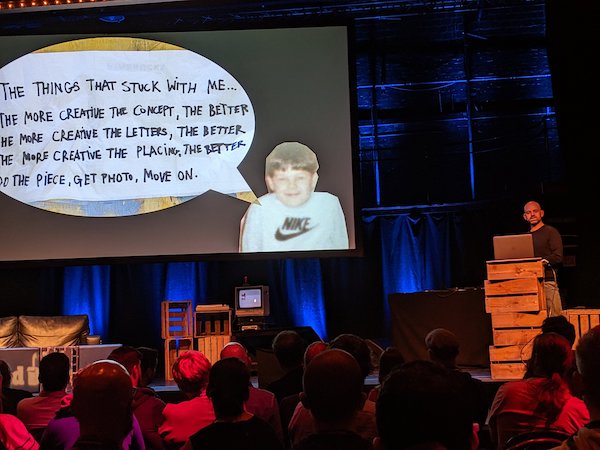
Rob’s talk was all about overcoming challenges, how important it is to always have a guiding principle you can follow, and that through persistence and hard work you will automatically create opportunities for yourself you never knew were possible in the first place.
Evening break session
Fabien Benetou (WebXR consultant at the Innovation Lab of the European Parliament, Mozilla Tech Speaker and working for the UNICEF Innovation fund) showed us the state of Virtual and Augmented Reality (VR/AR) in the browser by explaining the technologies surrounding these buzz words. It was kind of a plea for the open-source work done by Mozilla, which I like a lot.
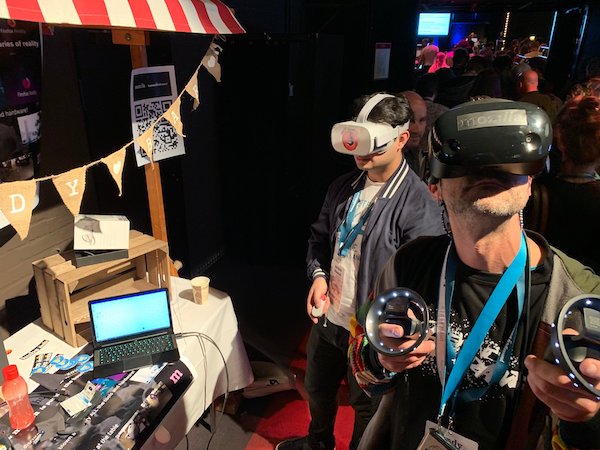
He showed why it is important to have trusted privacy rules for the VR/AR world by contrasting how companies like Facebook and Google try to get into this lucrative and still new and experimental venture of business.
The talk was a bit unstructured and hard-to-follow at times, but interesting nonetheless. I would have loved to see more hands-on examples and videos of what is possible right now in browsers regarding VR and AR.
Special appearance by the mayor
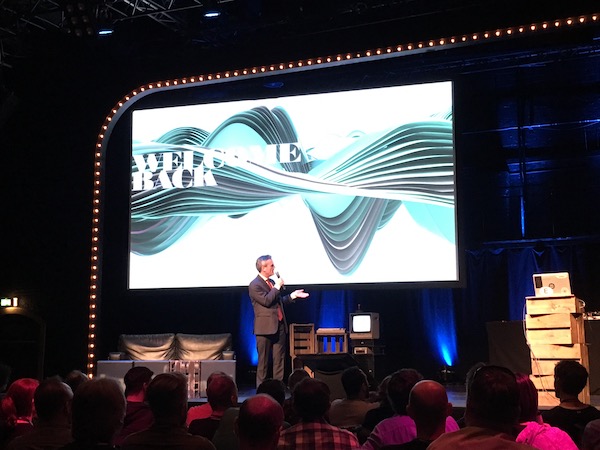
Suprisingly the mayor of Düsseldorf, Thomas Geisel, also showed up and gave a little speech thanking Marc for all his efforts surrounding the conference. It was nice to see some official recognition and I thought that it was a really nice gesture of him and the city of Düsseldorf.
“Imagination, desire and the call of the future”
David Delgado works as a Visual Strategist with The Studio at NASA’s Jet Propulsion Lab (parts of the stuff he worked on can be seen here: Visions of the Future). He talked about his fascinating work and showed how important it is to create bridges between hard sciences and the imagination of people (and especially children) to help make the problems scientists face more tangible, and to spark conversations around deeply important topics for the human race.
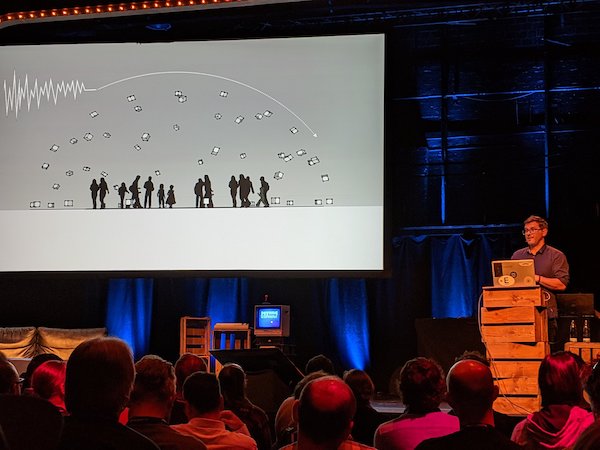
This was one of my favorite talks, I would recommend watching it. Super fun and awe-inspiring at the same time.
- David’s website
- David’s profile on the beyond tellerrand website
- watch the talk on Vimeo
- tweets surrounding the talk
Second conference day
“I don’t care what Airbnb is doing and neither should you”
Stephen Hay kicked off day two of beyond tellerrand in a beautiful manner: He reiterated the talks of the day before, making us aware of the fact that the topic of constraints (Charlie’s first talk) could be seen in almost every talk so far. A spot-on observation and how he put these thoughts into his slides and into his presentation the last minute showed his commitment to deliver a meaningful talk. Nicely done!

The talk touched something that everyone of us experiences in our jobs: we oftentimes blindly follow somewhat established “best practices” (be it for design or for development stuff), without questioning why and how these practices became “best” in the first place. Why, for example, is the functionality of the hamburger icon (and the hidden navigation menu) so prevalent? He explained the psychological basis for why people start to follow the advice of other people without questioning them and how this cascade of behavior leads to a result, where, at the end, nobody knows what the reasoning behind the result was in the first place.
His advice: Think critically. Go out of your comfort zone (a little bit), because only then you learn, you improve, and eventually you will get better results. We should try to come up with solutions to hard problems on our own, by thinking about the specific problems we are trying to solve for our users. One of my favorite talks of the conference!
- Stephen’s website
- Stephen’s profile on the beyond tellerrand website
- watch the talk on Vimeo
- tweets surrounding the talk
“Data, design, code”
Shirley Wu explained her thought process for creating impressive data visualizations. Starting from the data collection process, to thinking about how to best present the data, and eventually how to deliver a performant implementation of the visualization via code.

This was the only talk which had an extensive live coding part, so in that regard it (positively) stood out a bit in comparison to all other talks of the conference.
- Shirley’s website
- Shirley’s profile on the beyond tellerrand website
- slides of the talk
- code of the talk
- tweets surrounding the talk
“The Scoville scale of web font loading opinions”
Zach Leatherman delivered one of the view more technical talks by talking about what is dearest to his heart: type on the web. It was an insightful potpourri of tips and tricks regarding implementing web fonts for websites, also touching things like web font licensing, performance, and browser support.

I liked that he explicitly highlighted and praised Firefox’s font panel feature, which luckily didn’t go unnoticed.
- Zach’s website
- Zach’s profile on the beyond tellerrand website
- watch the talk on Vimeo
- slides of the talk
- tweets surrounding the talk
Lunch break session: Edge and Chromium
Christian Schaefer and Stefan Baumgartner from the Working Draft podcast invited to a podium discussion together with Chris Heilmann from Microsoft. The topic was the switch of Microsoft’s Edge browser to the Chromium rendering engine.

It was an interesting discussion with a lot of questions coming from the audience. Chris did a good job of answering all questions on behalf of Microsoft. The key argument he presented for why Microsoft did the switch: it was a pragmatic decision after looking into what developers around the world use and where the biggest momentum is right now. Microsoft rather wanted to jump on the Chromium train and actively engage and collaborate with a massive community with full force than to continue to work on an engine that is too much bound to the inflexible release cycles of an operating system.
His arguments were most of the time understandable for me, nonetheless it still leaves me with a bitter aftertaste having lost yet another rendering engine in the browser sphere.
“Napworking”
Doro Otterman is an illustrator and she walked us through her process of how she generates ideas for her work: it’s through napping. More specifically: the state between being awake and sliding into sleep; that’s where her creativity flows the most.
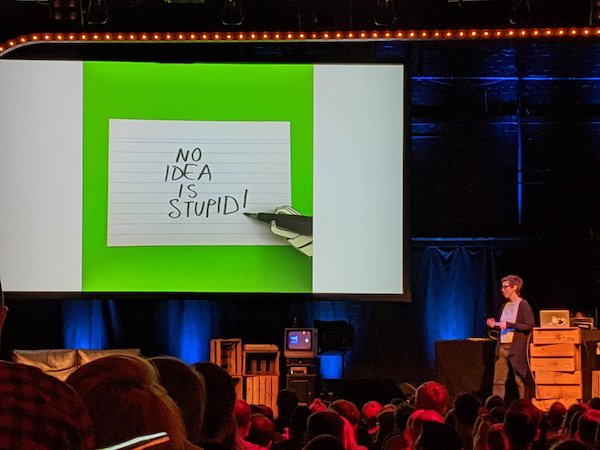
It was a funny talk, but at the same time it also touched a lot of deep concepts, e.g. to not belittle silly ideas as you never know how they unfold. The amount of potential around us is so vast, that it would be careless to overlook how the combination of two seemingly unrelated ideas could generate something meaningful and valuable for you and the people you address through your work.
- Doro’s website
- Doro’s profile on the beyond tellerrand website
- watch the talk on Vimeo
- tweets surrounding the talk
“Flexbox holy Albatross”
This was one of the few more technical talks at beyond tellerrand this year. Heydon Pickering did a step-by-step talk explaining a Flexbox trick that allows you to somewhat create a container query with pure CSS. Check out the corresponding blog post for the concepts behind it. Clever!
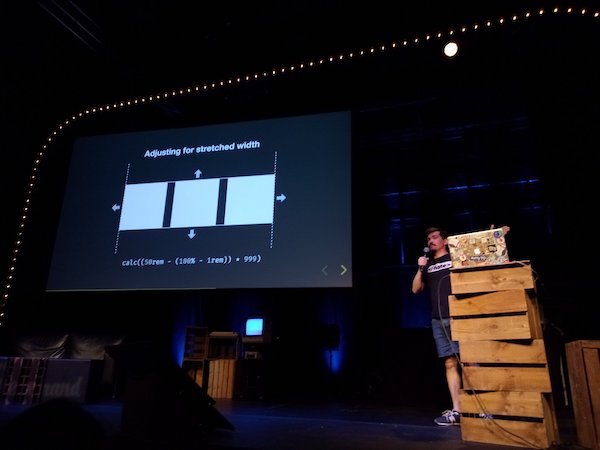
“Take back your web”
Tantek Çelik delivered a beautiful plea for the IndieWeb movement, and it was a really nice way to end the conference. He showed how the “corporate web” (in the clothes of Facebook and the likes) distorts the core principles of the web and creates anti-democratic tendencies which threaten our society and our democracy as a whole.

As an alternative he suggests taking things in your own hands again by getting yourself a domain and a webspace that you own. He showed how you can link and enrich independently owned content with comments, likes, etc. by using modern standards like Webmention. It was a really nice gesture of him to directly reference Matthias Ott’s excellent article Into the Personal-Website-Verse which also talks about this topic in detail.
- Tantek’s website
- Tantek’s profile on the beyond tellerrand website
- watch the talk on Vimeo
- tweets surrounding the talk
Other notable mentions
- The organisation of the whole event was superb. Marc Thiele did a great job at choosing the right combination of topics and speakers. Thanks, Marc!
- The venue, the Capitol Theater, is really well suited for such an event as it is spacious inside and outside.
- Tobi Lessnow was the DJ throughout the conference. He was live mixing in between sessions and it can’t be stated enough how important he is for the general vibe of the conference. He did such a good job, I sincerely love his music (you should check out his album Twilight Traveller on Bandcamp). Thanks, Tobi!
- Every spoken word on the stage has been live captioned on a screen right next to the main stage, which was quite fascinating to look at. The captioning was brought to us by White Coat Captioning, and Andrew from Scottland was our stenographer throughout the conference. Thanks, Andrew!
Conclusion
Again, Marc did an excellent job at organizing this year’s edition of beyond tellerrand at Düsseldorf. It was such an inspirational and friendly event. Thank you, Marc! I’m happy I didn’t miss it.
Edit (7 July 2019): adapted wording of a few formulations detected by Proselint.
